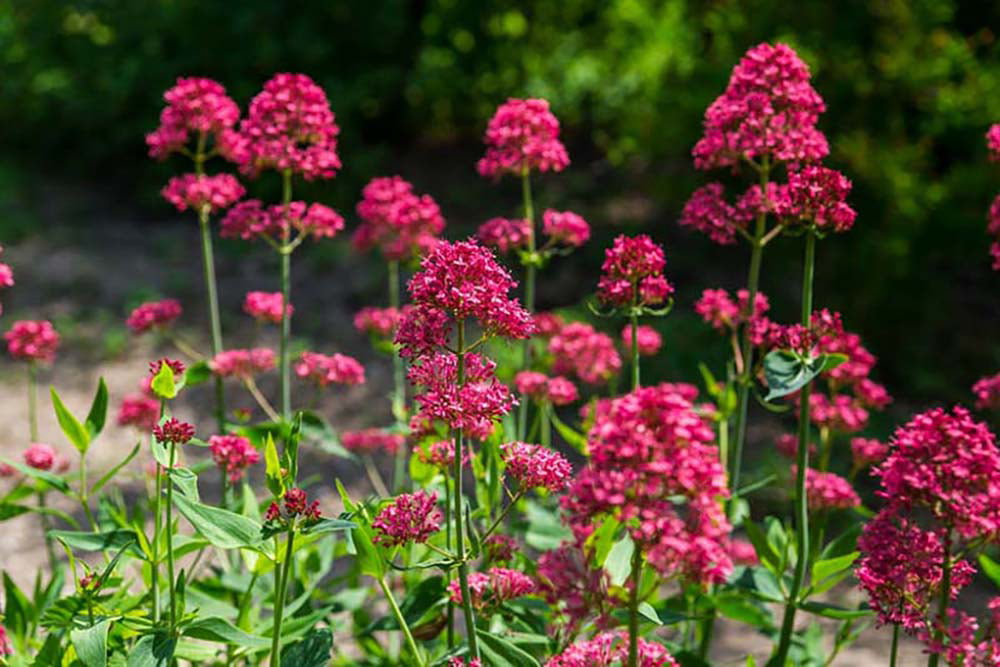With their sculptural spikes of tiny red, pink or white flowers, red valerian plants, also known by their botanical name Centranthus, are highly desirable additions to gardens and landscapes These rugged, easy-care perennials have an old-fashioned cottage garden charm and attract scores of pollinators. If you are looking to add red valerians to your yard, here is everything you need to know about purchasing these charismatic plants
What is Red Valerian?
Red valerian refers to a genus of flowering plants called Centranthus that contains about 10 species. These are herbaceous perennials or subshrubs native primarily to rocky areas and cliffs of southern Europe. The most popular and widely grown species is Centranthus ruber, known as Jupiter’s beard or bloody butcher.
With its loose, open form, red valerian grows 24-36 inches tall and 24-30 inches wide. From late spring to early summer, dense clusters of tiny starry flowers bloom at the tips of upright stems. Flower colors include bright crimson, carmine, pink and white. The foliage is attractive as well, with oval green leaves up to 4 inches long arranged in pairs along the woody stems.
Benefits of Red Valerian Plants
There are many reasons red valerian deserves a spot in gardens and landscapes
- Long bloom period from late spring to frost
- Flowers attract butterflies, bees, hummingbirds
- Rugged and adaptable to various conditions
- Tolerates heat, drought, poor soils, salt spray
- Works well in borders, cottage gardens, meadows
- Deer and rabbit resistant
- Easy care/low maintenance
- Delightful cut flowers
- Spreads by self-seeding, but not aggressively invasive
Where to Find Red Valerian Plants for Sale
Red valerian plants are sold at many garden centers and plant nurseries, especially in the spring. However, selection is often limited to just one or two common varieties like Centranthus ruber.
For the widest choice of different centranthus species and cultivars for sale, check out online perennial specialists like:
-
Plant Delights Nursery – Offers Centranthus ruber ‘Coccineus’ and other unique selections.
-
High Country Gardens – Sells popular Centranthus ruber ‘Coccineus’ with red blooms.
-
Bluestone Perennials – Carries Centranthus ruber ‘Albus’ with white flowers.
-
Nature Hills Nursery – Provides the dwarf pink cultivar Centranthus ruber ‘Pretty Betsy’.
These and other reputable online sellers ship healthy, vigorous plants straight to your door. Order early for the best selection.
How to Plant Red Valerian
Here are some tips for successfully planting red valerian in your garden:
-
Sun: Choose a site with full sun to part shade. At least 6 hours of direct sunlight is ideal.
-
Soil: Red valerian tolerates most soils as long as they drain well. Lean, rocky or sandy soil is fine.
-
Spacing: Allow 18-24 inches between plants. Give them room to spread.
-
Planting: Set plants at the same depth they were growing in pots. Water well after planting.
-
Care: Apply a thin layer of compost each spring. Avoid fertilizing which can cause floppiness.
Growing and Caring for Red Valerian Plants
To keep your red valerians looking their best, provide the following care:
-
Watering: Drought tolerant once established. Water deeply only when soil is dry.
-
Pruning: In early spring, cut back flower stems to promote bushy new growth.
-
Fertilizing: Avoid high nitrogen fertilizers which cause leggy growth.
-
Winter Care: Leave spent flower stems over winter for visual interest and bird habitat.
-
Propagating: Easily self-seeds but not aggressively. Thin unwanted seedlings.
With proper siting and minimal care, red valerian plants will thrive, naturalize and provide years of beauty to your landscape. Their vibrant colors and carefree nature make centranthus a must for gardens.
Popular Red Valerian Varieties
Many species and cultivars of Centranthus offer unique flower colors, plant sizes and growing habits. Here are some top varieties to consider:
Centranthus ruber
-
‘Coccineus’ – Most popular variety with bright red blooms. Grows 24-36 inches tall.
-
‘Albus’ – White-flowered form with green foliage. Compact at 18 inches tall.
-
‘Pretty Betsy’ – Dwarf growing to 12 inches tall with pink flowers.
Other Notable Centranthus Varieties
-
C. macrosiphon – Pink flowers on 18 inch stalks. Leaves have white margins.
-
C. angustifolius – Pink blooms on stiff stems. Narrow willow-like leaves.
-
C. calcitrapae – White starry flowers with glaucous foliage.
Where to Use Red Valerian in Gardens
Thanks to their rugged nature, red valerians are very versatile plants that work well in many garden situations:
- Cottage gardens
- Perennial borders
- Container gardens
- Pollinator gardens
- Rock gardens
- Meadows and naturalized areas
- Hillsides and slopes
- Seaside gardens (tolerates salt spray)
Plant red valerian in drifts or clusters for best visual impact. You can also mix them with other perennials like yarrow, catmint, coreopsis and ornamental grasses. They combine beautifully!
With minimal care, Centranthus are hardy performers that inject beauty and elegance into gardens. Their delightful flowers will attract admiration from people and pollinators alike. When shopping for plants this spring, be sure to pick up one or more of these charismatic red valerian varieties to enhance your landscape all season long.
Description24-36″ tall x 30″ wide. This is such a versatile plant, being equally at home in both the xeric garden and traditional perennial border. Not fussy about its growing conditions, it has showy rose-red flowers that are continuous from late spring through summer. Prefers a well-drained garden soil. Not recommended for coastal areas of CA, WA and OR, where it can behave aggressively. Cut back in the spring. (seed propagated).

Centranthus ruber (Jupiters Beard) is a long-blooming European wildflower that is easy-to-grow and provides ample nectar for butterflies.
Preferred growing conditions:
- Centranthus does well in a lot of different types of soil, even clay.
- Different types of mulch, such as gravel in water-wise landscapes (xeriscapes), can be used to cover it in dry climates.
- After the second growing season, it only needs deep watering every once in a while. Take care not to overwater established plants.
- Plant in full or part sun conditions. (Plants can fall over if they are planted in part shade and get too much water.) ).
- This is enough: just a few handfuls of compost and Yum Yum Mix should be enough to fill the hole. This plant doesnt like a rich, highly-amended soil.
Special comments:
- Centranthus will sprout again and again, and it can look like weeds in a wet garden. By cutting off the spent flowers at the end of the spring or beginning of summer bloom, you can get rid of unwanted seedlings.
Garden care:
- Feed Centranthus only once in the fall with Yum Yum Mix and Planters II.
- If you live in a wet area, cut back the stems to about 2 to 3 inches tall in late fall to keep the leaves and stems from rotting.
- In dry parts of the west, don’t cut them back until mid-spring.
| Zone | Shipping Status |
|---|---|
| Zone 2 | Now Shipping |
| Zone 3 | Now Shipping |
| Zone 4 | Now Shipping |
| Zone 5 | Now Shipping |
| Zone 6 | Now Shipping |
| Zone 7 | Now Shipping |
| Zone 8 | Now Shipping |
| Zone 9 | Now Shipping |
| Zone 10 | Now Shipping |

Together, we’re improving the earth, one garden at a time
calm journey into the realm of beautiful red valerian, centranthus ruber
FAQ
Is red valerian easy to grow?
Is red valerian the same as valerian?
Is red valerian invasive?
How far apart should I plant red valerian?
|
Hardiness
|
5 – 8 What’s My Zone?
|
|
Spread
|
1′ – 2′ (30cm – 60cm)
|
|
Spacing
|
18″ – 24″ (50cm – 60cm)
|
|
Maintenance
|
Low
|
|
Water Needs
|
Average
|
Is red valerian a perennial?
Bushy, well-branched, with one of the longest blooming seasons, Red Valerian (Centranthus Ruber) is a popular perennial grown for its ornamental and showy star-shaped flowers. Fragrant, this border beauty is easy to grow, fairly pest and disease free, and attracts butterflies. What else to ask for?
What does a red valerian flower look like?
Red Valerian ( Centranthus ruber) features showy clusters of tiny salmon-rose flowers that appear along 3″ stems. Pretty and rugged, this Mediterranean native blooms for what seems like forever—from late spring to August here—and its gray-green leaves contrast nicely with deeper greens in the border. Butterflies like it, too.
Is red valerian easy to care for?
There is no plant that is easier to care for than red valerian, and on top of this, it doesn’t even fear diseases or parasites. Red valerian, or Centranthus ruber, owes its name to the botanist De Candolle, who likened its flowers to a red spearhead (kentron means spear in Greek, and anthos means flower and ruber means red).
- The Ultimate Guide to Growing Strawberries in Raised Beds - August 8, 2025
- No-Dig Garden Beds: The Easiest Way to Grow a Beautiful Garden - August 6, 2025
- How to Protect and Preserve Wood for Raised Garden Beds - August 6, 2025

